Recent technological advancements have simplified the process for oil & gas operators to identify and measure methane among other greenhouse gas (GHG) emissions, leading to improved management, mitigation, and reduction of these emissions. The introduction of Optical Gas Imaging (OGI) has revolutionized the way emissions are detected and addressed.
Apart from being highly efficient, the OGI method offers a wide range of advantages. Both cooled and uncooled OGI Cameras enable users to detect fugitive emissions of up to 400 hydrocarbons and VOC gases. It is crucial for users to familiarize themselves with the key distinctions between these two types of equipment to guarantee efficient processes.
By Gobind Khiani M. Eng., P.Eng., Fellow, Mechanical Engineering – Piping/Pipelines
Annually, the oil & gas industry emits a few million metric tons of fugitive methane emissions. This can result in frequent loss of products for operators which has led the industry to search for a way to find and mitigate the natural gas leaks at various escape points. Escape points for emissions include compressor stations, processing plants, hydraulically fractured wells, tie-in and gathering pipelines, and so on.
For many years, leak detection and repair has been an Environmental Protection Agency (EPA) protocol called Method 21. Method 21 employs the use of a Toxic Vapor Analyzer (TVA). A TVA has the capability to detect gas leaks and field inspectors use this equipment to ‘sniff’ for leaks. After an assessment is complete, plant engineers investigate further to determine the source.
In June 2016, the EPA recommended OGI as an alternative to TVAs. The Environmental Protection Agency declared this innovation to be the ‘best system of emission reduction’ at well sites and compressor stations.
Gas imagers are infrared cameras equipped with special filters that visualize methane and volatile organic compounds (VOCs). These gases absorb mid-wave infrared radiation, blocking any radiation coming from objects behind them. The camera detects the gas plume as a shadow that stands out against the thermal radiation of the surrounding area.
Optical Gas Imaging SK: (OGI)
OGI refers to thermal imaging technology that uses high-sensitivity infrared (IR) cameras to detect fugitive emissions of industrial gases. OGI cameras can help operators detect hydrocarbons, sulfur hexafluoride, refrigerants, and hundreds of other industrial gases quickly, accurately, and safely – without shutting down systems. OGI can also provide visual confirmation of leaks as small as 0.35 g/hour. The main advantage of OGI is its ability to scan large areas and picture gas plumes in real-time. This helps inspectors pinpoint the source of fugitive emissions and begin the repair process immediately, making OGI inspections more efficient than Method 21 surveys.
During a field study conducted, surveyors determined that scanning with infrared cameras was at least nine times faster than performing Method 21 scans on the same site equipment. The speed of OGI scans makes it easier for oil & gas producers to survey equipment more often. The EPA notes that more frequent inspections and repairs can reduce fugitive methane and VOC emissions significantly. For example, quarterly surveys can cut emissions by 80%, while semi-annual monitoring surveys and repairs can reduce emissions by 60%. USD $4 per million Btu is the estimated gas savings from the repair of identified leaks, which exceeded the labor and material cost of anticipated repairs.
OGI-based LDAR programs have been essential in estimating hundreds of tons of volatile organic compound emissions from emitting into the atmosphere. Not only does this help the environment, but it also keeps the gas in the pipes; this saves money, and protects the refinery or plant, minimizing the potential of an explosive atmosphere.
State-Level Regulations
OGI is accepted by the EPA and Bureau of Land Management and state-related environmental agencies. Many states including Colorado, Wyoming, California, Pennsylvania, North Dakota, and Ohio, have OGI regulations. In addition, some states are currently considering allowing companies to report methane leaks, without worrying about incurring a fine, provided the leak is adequately repaired in the specified time frame. Overall, changes to state regulations could result in more efficient inspections and repair of leaks. The EPA suggests that mitigating emissions with OGI at just 10 to 20% of sites with gas leaks would result in a 60 % reduction in methane emissions.
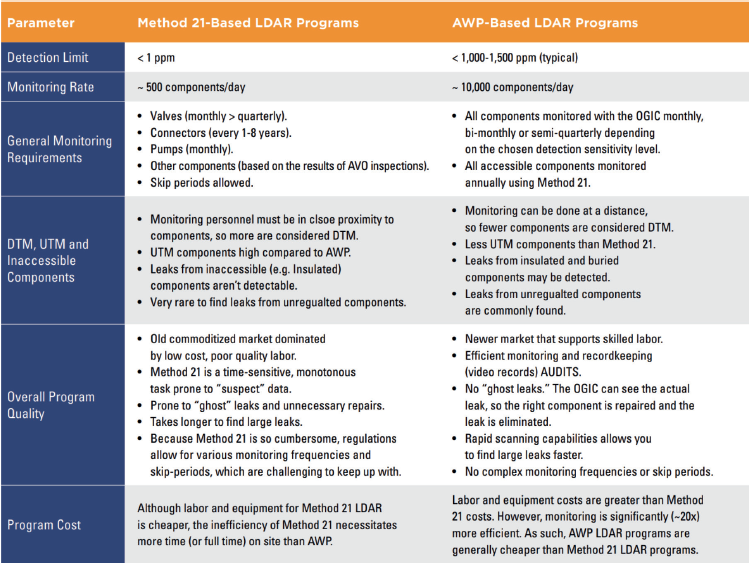
Cooled & Uncooled OGI Technology
A cooled OGI camera is very sensitive compared to an uncooled camera. In the mid-wave spectrum, there is a very strong absorption response to compounds such as Methane, Hexane, Butane and over 400 other VOCs.
In the longwave infrared spectrum, where the uncooled OGI technology is used, there is a weaker absorption response for VOCs. It is more difficult to detect these VOC compounds, apart from methane emissions, which can be detected in much larger concentrations.
Certain OGI cameras can quickly identify fugitive gas emissions for over 400 hydrocarbon and VOC gases, including methane and CO2. An OGI camera is considered intrinsically safe and complies with the EPA’s ‘Quad Oa’ (OOOOa) regulations. It is certified and classified for hazardous environments ANSI/ISA-Class I and II, Div. 2, & Class III, CSA C22.2 Class I, Div. 2 and ATEX II, IECEx EMT 19.0006X as Intrinsic Safety ‘ic’, protection ‘n’.
This technology has a wide range of unique features making it a successful method used to identify emissions. OGI cameras help to detect and repair gas leaks inside the facility limits without the need for a hot permit, allowing video and audio recording and streaming, while maintaining safety. There are companies that offer both cooled and uncooled technologies. End users should familiarize themselves with the difference between the two technologies including the benefits and limitations.
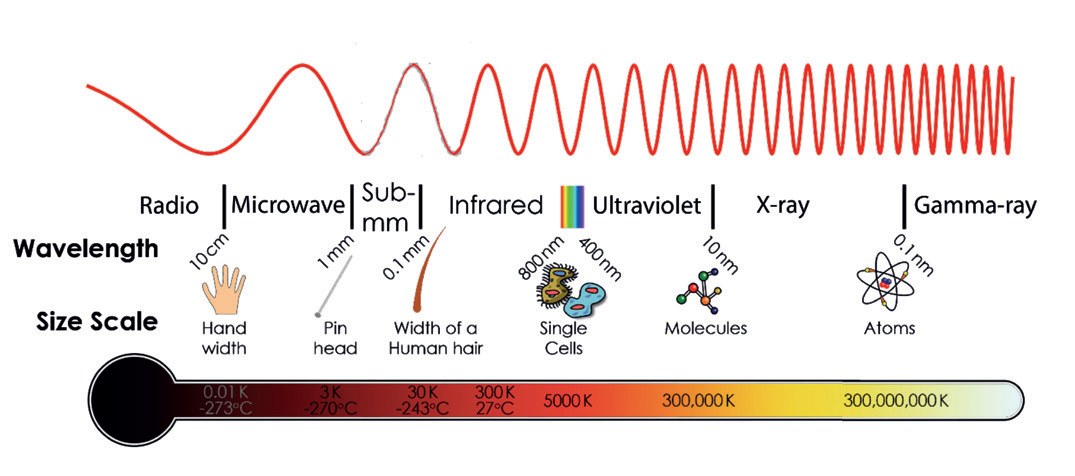
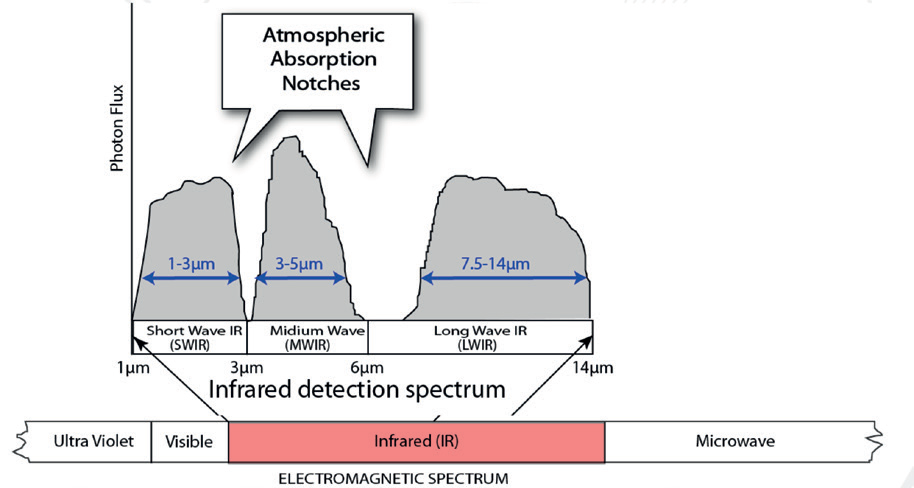
What is the Difference Between Them?
Before deep diving into the differences between cooled and uncooled technologies, it is important to understand the electromagnetic spectrum. In a nutshell, the electromagnetic spectrum refers to the travel of a photon (a tiny particle that comprises waves of electromagnetic radiation)—for example, light or sound. In the spectrum, there is also infrared radiation, which is invisible to the naked eye.
With a thermal camera, it is possible to visualize this spectrum.
The infrared spectrum comprises of SWIR (Short Wave IR), MWIR (Mid- Wave IR) and LWIR (Long Wave IR), see Figure 1. However, only MWIR and LWIR are relevant for thermal imaging. SWIR is outside the thermal imaging spectrum and not relevant to OGI technology, see Figure 2.

Cooled OGI cameras have a cryogenic cooler inside them, enabling the thermal camera to ‘see’ compounds in the MWIR. The uncooled OGI cameras work without a cryogenic cooler, making them less sensitive, so operators can only ‘see’ compounds in the spectrum’s LWIR (long wave) region.
It is essential to note that not all compounds have the same absorption characteristics and are visible in different wavelengths, see Figure 3. After understanding the infrared spectrum, operators can identify visible compounds in these wavelengths.
In the MWIR, when the cooled OGI technology is utilized, Methane, Propane, Benzene, Toluene, and over 400 VOCs are detectable. Figure 3 outlines an example of a few compounds and their absorption characteristics.
In the LWIR, compounds can be seen using an OGI camera without the need for a cooler. In this area of the spectrum, higher concentrations of Methane are detected. Additionally, SF6, Ammonia, and HFCs are also visible. Figure 4 demonstrates the absorption characteristics of these gases.
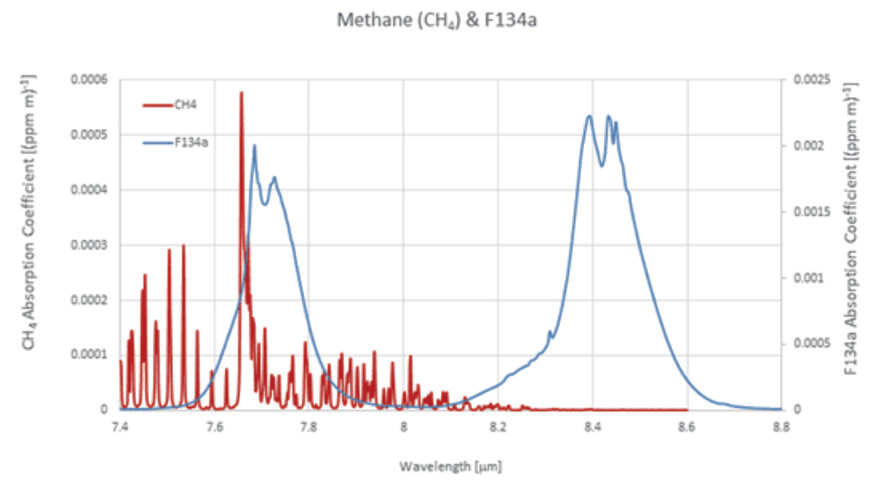
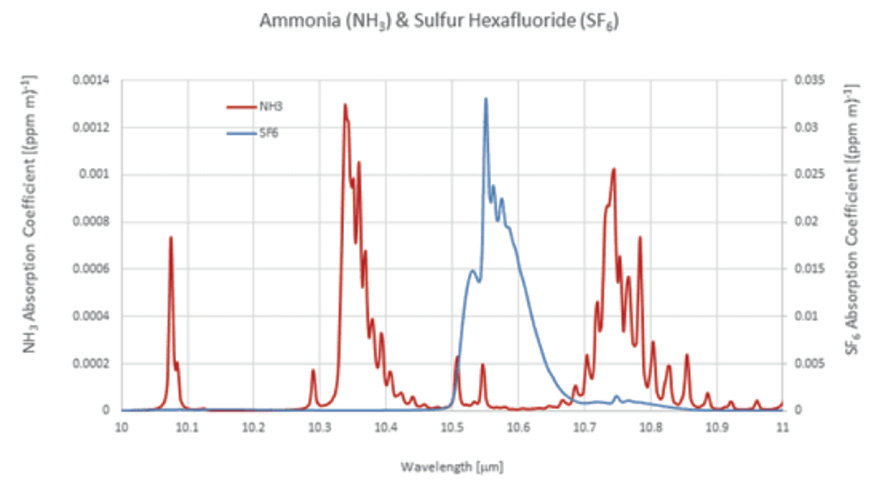
Conclusion
A cooled camera can detect many more compounds, Methane, CO2, CO and 400 VOCs, in much smaller concentrations. In comparison, the uncooled camera is limited to Methane in medium to large concentrations, Ammonia, SF6 and HFCs. Cooled OGI cameras provide high quality images, are very sensitive, and are more expensive than uncooled cameras. Tiny leaks of Methane, CO2, CO, and over 400 VOCs are visible from distances as far as 10 kilometers (6.2 miles) away.
Uncooled OGI cameras, on the other hand, are not as sensitive as cooled OGI cameras. This type of equipment is usually higher in cost and obtains lower image quality compared to the cooled camera. Uncooled OGI cameras can detect medium to large Methane leaks from closer distances, in addition to SF6, Ammonia, and HFCs emissions.
It would therefore be beneficial for operators to understand the benefits and limitations of the OIG technologies and implement them in plants and refineries to mitigate the risk of harmful emissions leaking to atmosphere.
References:
- OPGAL, IIan Waldman
- Contributions from articles from FE Journal
- June 2018, Article Optical Gas Imaging at a Natural Gas Producer
- March 2019, Article Optical Gas Imaging Versus Method 21 for Detecting Hydrocarbon Emissions
- September 2020, Article Advancements in Optical Gas Imaging & Infrared Cameras



